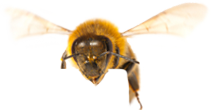
As temperatures rise in Denver, voles and mice become more active, seeking food and shelter in yards, gardens, and homes. These small rodents may seem harmless, but they can cause significant damage to landscapes and structures if left unchecked. From tunneling through lawns to chewing on wiring, their presence can lead to costly repairs and persistent infestations.
Understanding how to spot, prevent, and remove these rodents early in the season is key to keeping your property rodent-free. This guide provides essential steps for identifying vole and mouse activity, implementing effective prevention measures, and exploring removal options.
Voles and mice are often mistaken for one another, but their behavior and the type of damage they cause differ. Recognizing the signs of each rodent can help you determine the best course of action.
Signs of Activity:
Signs of Activity:
By recognizing these signs early, homeowners can take proactive steps to prevent a rodent infestation before it worsens.
Voles and mice are attracted to yards that provide easy access to food and nesting areas. Removing these attractants is the first step in keeping them away.
A well-maintained yard is less inviting to rodents, making it harder for them to establish colonies.
Voles are notorious for damaging lawns, gardens, and tree roots. Implementing targeted strategies can help minimize their impact.
If vole activity is already visible, these preventative measures can help slow further damage while removal strategies are put in place.
While voles primarily stay outdoors, mice will take advantage of small openings to enter homes, garages, and sheds. A single mouse can squeeze through a hole as small as a dime, making exclusion crucial for prevention.
Inspect the exterior of your home for cracks, holes, or gaps, especially around foundations, doors, and windows.
If voles or mice have already moved onto your property, traps can be an effective method for removal. Different trapping methods work best for different rodents.
For larger infestations, professional pest control services may be needed to ensure complete removal.
While DIY solutions can help reduce rodent populations, professional intervention may be necessary for persistent vole or mouse infestations. A pest control specialist can assess the severity of the issue and provide targeted treatments to remove rodents and prevent future problems.
If voles or mice are becoming a problem in your yard or home, seeking expert assistance can provide a long-term solution.
Voles and mice can cause significant damage to lawns, gardens, and homes if left unchecked. By identifying early signs of activity, eliminating food and shelter sources, sealing entry points, and using effective removal methods, you can keep your property rodent-free this spring.
For professional rodent control services in Denver, contact Animal & Pest Control Specialists. Our experienced team provides customized solutions to protect your yard and home from unwanted pests.
Mice can contaminate food-preperation areas with their feces and can cause severe damage to structures.
Here are the signs you should be looking for to identify new pest problems this season.
We offer all the pest control services you need, including prevention, removal, and extermination.
It’s hard to understand the value we offer until you’ve tried us. Our discount makes it easier for new customers to get the best value in pest control.